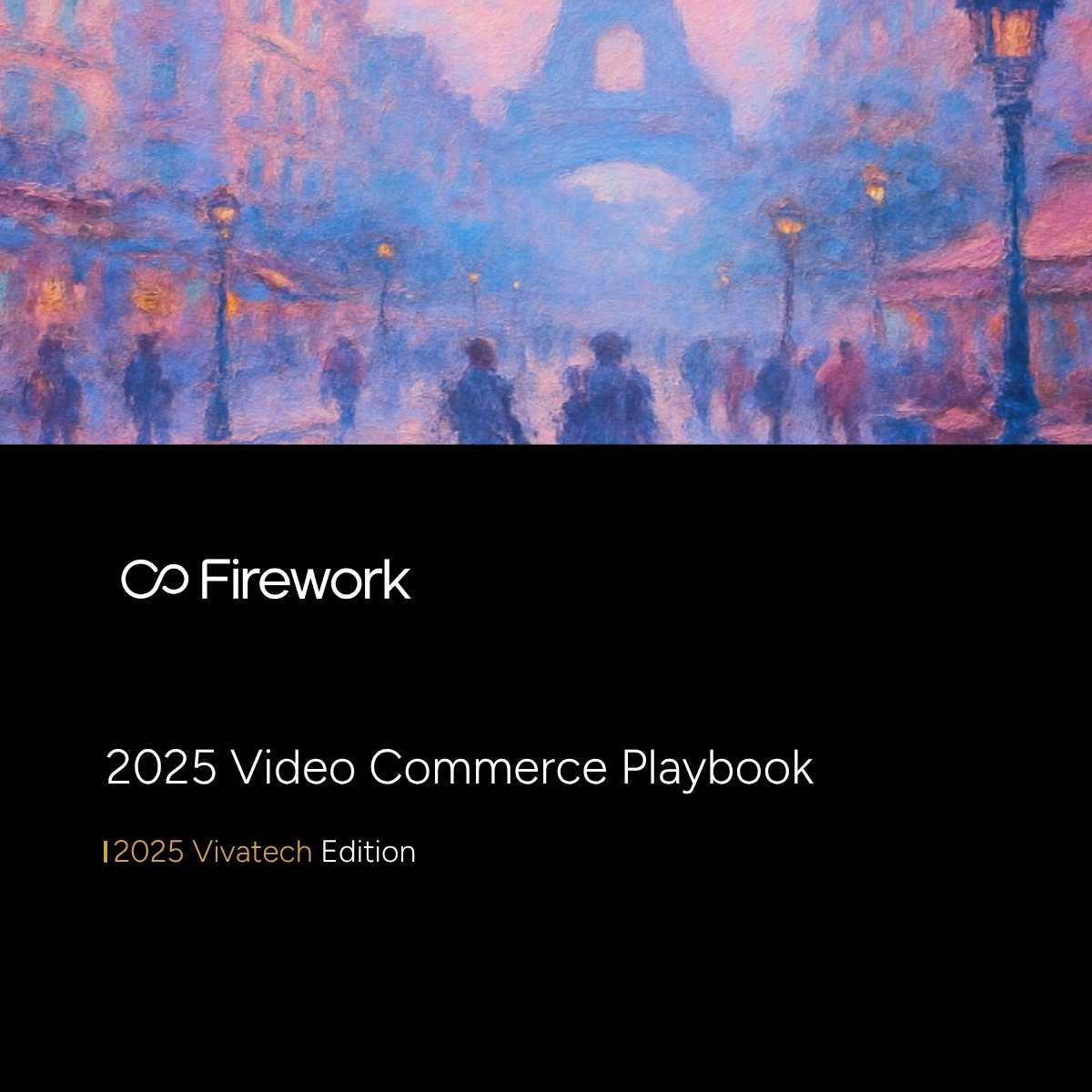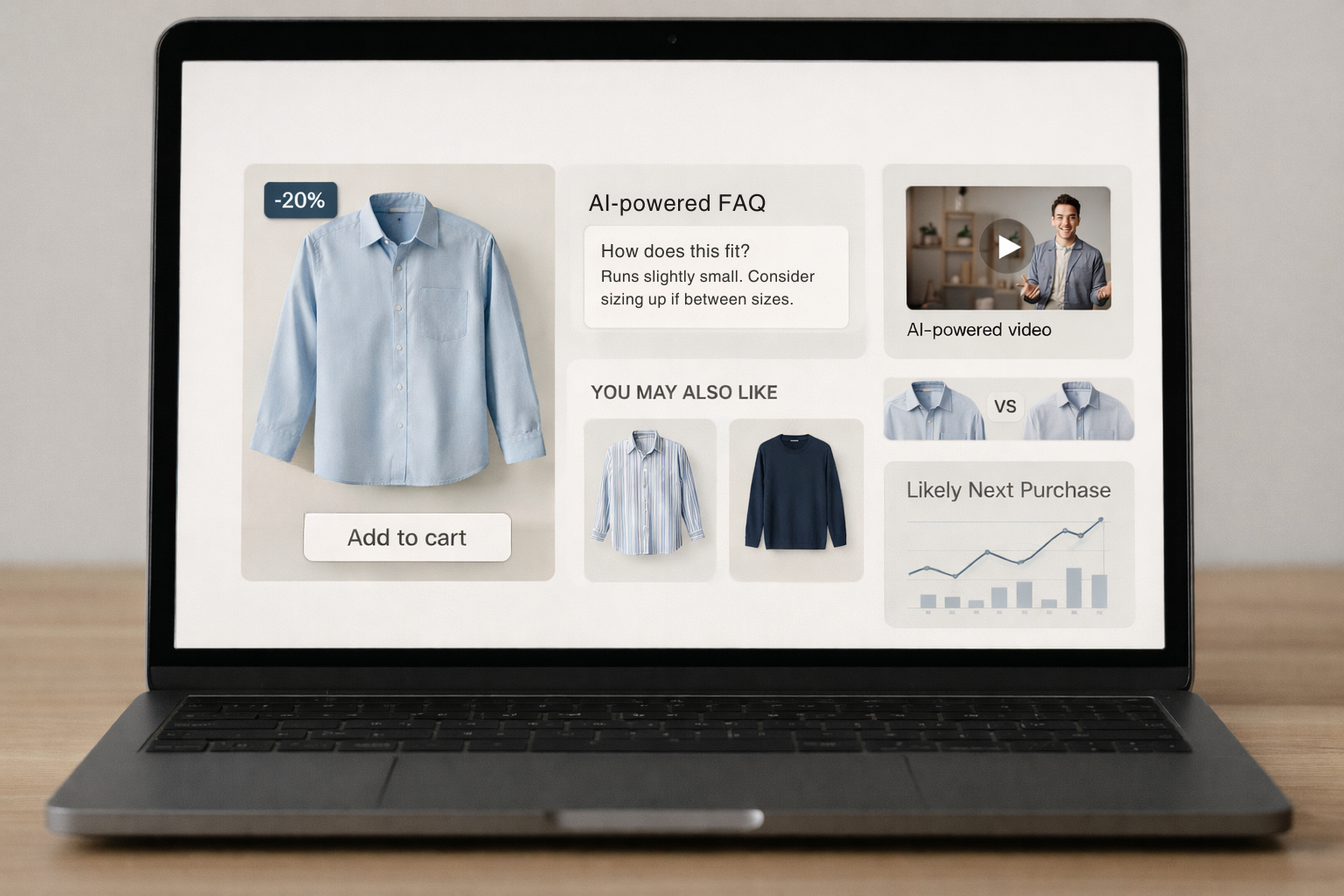Artificial intelligence is the competitive differentiator separating winners from everyone else. Machine learning, computer vision, and conversational AI transform workflows into data-driven growth engines.
The stakes are high. Retailers using AI report higher profit growth compared to laggards, while most consumers remain loyal to brands that offer personalized experiences.
AI's advantage is creating entirely new business models, from video showrooms to autonomous supply chains, that keep you ahead of market shifts. These seven transformative applications span the full retail value chain, driving measurable growth that transforms customer connections and operational excellence.
1. Personalized Product Recommendations
When you land on a retail site and see hand-picked products, recommendation engines are working behind the scenes. These models analyze browsing history and clicks to surface items you'll love, transforming endless scrolling into a curated discovery experience.
Retailers are seeing measurable results from recommendation engines that tailor product suggestions in real time. These tools help customers discover what matters to them, faster. When done well, personalization strengthens loyalty by making shoppers feel understood and valued at every touchpoint.
Examples & Implementation
Amazon's "Frequently Bought Together" module sets the gold standard. Beauty brands feed skin-type data to suggest products in real time.
Business Impact
Intelligent systems lift conversion rates 1.7x over traditional merchandising. Product recommendations increase revenue by 26% as complementary items appear at the perfect moment. Personalized experiences drive 40% more revenue through repeat purchases, while also reducing cart abandonment.
2. AI-Powered Chatbots & Virtual Assistants
Intelligent chatbots never clock out. Using large language models, these virtual assistants understand natural language and respond instantly. Embed them on your site or in messaging apps for 24/7 support that feels human.
Every chat provides insights into customer concerns and product trends. Shoppers can track their orders, initiate returns, or receive personalized recommendations in seconds. Virtual stylists assist with fit, while booking bots schedule in-store consultations.
Examples & Implementation
Businesses implementing automation see measurable improvements, with customer satisfaction scores increasing by 1% within 30 days and automation leaders achieving 17% reductions in process costs.
Business Impact
Automated support slashes wait times while boosting satisfaction. Support costs decrease through reduced ticket volume and shorter handle times. Every interaction becomes an opportunity to engage customers with rich, interactive content.
3. Visual Search & AR Virtual Try-On
Snap a photo, upload it, and instantly see similar products. Visual search utilizes computer vision to match images with catalog items, eliminating the need for keyword guessing. Google Lens processes 8+ billion visual searches monthly.
AR virtual try-on lets shoppers preview makeup, test sneakers, or place furniture in their living rooms, merging in-store assurance with e-commerce convenience. This creates longer sessions and richer personalization data.
Examples & Implementation
Sephora allows customers to virtually test foundations before making a purchase. Eyewear brands overlay frames on live video. Fashion retailers create virtual fitting rooms where shoppers rotate outfits in 3D, while furniture sellers place true-scale items in homes.
Business Impact
Retailers report significant conversion increases, with some brands seeing rates triple when using AR features, and 20-30% fewer returns as customers buy what they've already 'seen.' Interactive try-ons double engagement time and offer valuable behavioral insights from customer interactions. Product visualization gives shoppers 45% more confidence to complete purchases.
4. Demand Forecasting & Inventory Management
Machine learning transforms inventory planning. Intelligent models analyze sales history, events, weather, and social signals to create real-time forecasts. These continuously update reorder points and safety stock levels, ensuring a perfect balance of inventory.
Walmart's system analyzes data from over 4,700 stores, incorporating weather and demographics while filtering out anomalies. Smaller retailers employ similar algorithms to establish dynamic safety stocks for volatile items, thereby creating responsive supply chains.
Examples & Implementation
Precise forecasts cut supply-chain errors by 50% and boost efficiency by 85%. Leaner inventory reduces carrying costs and markdowns, while freeing up capital, often trimming stock by 20-30% without sacrificing availability.
Business Impact
When the right products are always available, shoppers find what they want, margins stay healthy, and retailers gain working capital for new initiatives. The system reacts intelligently to demand fluctuations rather than panicking.

5. Dynamic Pricing Optimization
Intelligent pricing adjusts tags in real time, maximizing profit. ML models scan demand, inventory, seasonality, and competitors to determine optimal prices for every SKU. Updates happen in seconds, raising prices for viral items and lowering them when interest wanes.
The same engine personalizes offers for loyalty members while striking a balance between revenue and satisfaction. Algorithms handle the math while you focus on strategic goals, margin, market share, or both.
Examples & Implementation
Grocery chains adjust prices on storm-related items as forecasts shift. Fashion brands use influencer spikes to boost engagement and sales, but there is no evidence that they implement surge pricing during these periods. Beauty retailers offer tier-specific discounts. Automated tools continuously optimize markdown calendars to clear seasonal inventory profitably.
Business Impact
Retailers using effective pricing strategies and inventory optimization achieve 2-7% increases in return on sales alongside improved inventory management. This means fewer clearance sales and healthier cash flow. Dynamic pricing maintains a competitive edge without price wars, transforming guesswork into precision growth.
6. Supply Chain & Logistics Optimization
Modern logistics is a self-learning network that adapts faster than humans can manage. Route-planning systems analyze traffic and weather to create efficient schedules that can be adjusted mid-route. Warehouse sensors detect equipment issues before failures occur.
Systems continuously optimize inventory placement by weighing forecasts against shipping costs to ensure optimal allocations. They monitor social media, geopolitics, and weather to flag disruptions early.
Examples & Implementation
Delivery companies recalculate thousands of stops every few minutes. Vibration-analysis models predict equipment maintenance needs. Fashion retailers select optimal fulfillment locations while grocers pre-position inventory before storms.
Business Impact
Automated logistics reduce transportation costs by 10-20% while improving delivery performance. Disruption detection cuts stockouts, and predictive maintenance reduces downtime. Precision routing lowers fuel consumption, appealing to eco-conscious consumers.
7. Marketing, Segmentation & Customer Insights
ML transforms shopper behavior into actionable insights. Models analyze every interaction to predict future purchases, optimal channels, and risk of churn. Unlike static segments, these systems create dynamic groupings that update in real time.
They analyze social sentiment to inform personalized campaigns across email, mobile apps, and in-store screens. Every touchpoint is tracked, connecting marketing spend directly to sales outcomes.
Examples & Implementation
Retailers use predictive analytics to identify high-value shoppers for VIP treatment. Micro-segmented emails target specific style preferences. Social teams adjust messaging based on sentiment analysis. Attribution engines automatically shift budgets to top-performing channels.
Business Impact
Brands that utilize intelligent personalization often experience significant sales and profit increases. Customer loyalty increases, with 65% of consumers saying they are more likely to stay loyal when companies offer personalized experiences. Smarter targeting reduces waste while boosting lifetime value and freeing teams for strategic work.
AI-Powered Retail Revolution
Machine learning isn’t just changing retail; it’s reshaping how brands grow, compete, and connect. When used across your entire operation, AI shifts your strategy from reacting to demand to actively influencing it.
The real advantage comes when AI is treated as a core business driver, not just a set of disconnected tools. Success depends on setting clear goals, organizing your data, and moving quickly from insight to action.
This is where Firework stands out. Its video commerce solution turns product discovery into a personalized, always-on experience, bringing your brand to life while converting attention into results. Book a demo to get started!
Unlock Exclusive Insights
By submitting this form, you agree to Firework's privacy policy and consent to receive personalized marketing communications. You can unsubscribe at any time.




























